
One of the most daunting things about bringing a new puppy home is teaching him the lay of the land and the rules of the house. Puppy training is an ongoing process and can extend well into adulthood. Pet parents have to get ready to teach their new fur babies everything from where they can go potty, to what specific words mean.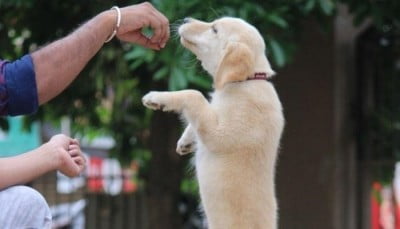
Photo by Abhishek Shivhare from Pexels
We understand if you’re overwhelmed because sometimes even the most experienced of us can be. Hopefully, we can alleviate some of the stress with our comprehensive puppy training guide.
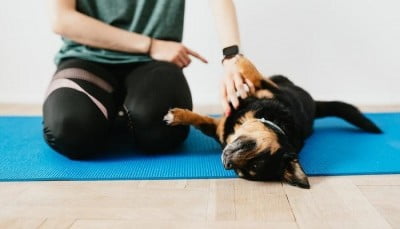
Photo by Karolina Grabowska from Pexels
Before you even consider starting to train your pup, there are a few things to establish first to make it easier for you. These are things you can teach your pup during everyday life and not specific training sessions.
Focus
You can’t expect to get anywhere with your pup if he’s not paying attention. A young puppy’s attention span is short, and he will likely be distracted by many things. Your goal is to be able to call his name (also useful so your pup knows his own name) and have him at least look at you and establish eye contact.
Once eye contact is locked, your dog is registering what you’re saying. Even if in the beginning your pup breaks eye contact in just a few seconds, it’s still considered a win. After a while, it will be easier to get your dog to focus on you and learn the commands with practice.
Keywords
Aside from his name, two other very important keywords that we have learned are very useful are “no” and “good girl/boy”. One is affirming your dog’s actions and the other one is discouraging unwanted behavior. Trust us when we say these two keywords are going to be indispensable throughout your dog’s life.
Whether it’s for teaching your dog what he can or cannot do, or to keep your dog safe, having your canine discern between “good” and “no” will help them understand your expectations quickly.
Socialization
Having a well-socialized pup isn’t so much training you have to do rather than a lifestyle you give your pup. Dogs need socialization, which is not just interacting with other dogs, but also getting to know the world around them. This way, your dog is less likely to develop a frightened and anxious personality if he’s “seen the world”.
A well-socialized pup will grow to be well-developed and well-rounded, have a better temperament, and will more likely be friendly.
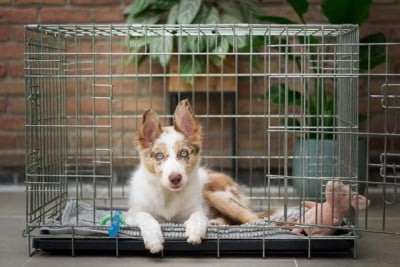
Photo by Ayla Verschueren on Unsplash
Puppy training can be divided into commands and essential habit training. We’ll cover the latter first.
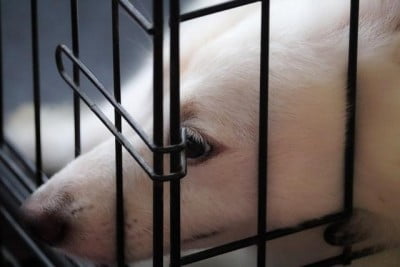
Photo by Pavan Naik on Unsplash
Many dog parents spend a lot of time Googling what to do when they welcome their new puppy home, and crate training will definitely have come up.
What is crate training? It’s one of the essential lessons to teach your pup when he’s young. It allows him to associate positive things with his crate and for it to become a place of safety, comfort and security. Not to mention, it’s also very helpful to be used in tandem with potty training.
How can you expect your pup to love being in the crate if it’s not comfortable? Set up the place with a doggy bed, blanket, pillows, and whatever your dog likes to make it a happy place.
Don’t just shut your pup in the crate right away, you will set crate training back. Feed treats and meals inside so your pup knows it’s a safe place.
Shut close the door a bit more each time until it’s completely shut. The first time it closes fully, only do it for a few seconds and then lengthen the time as your dog gets used to it. If he starts to cry, then take a step back and shorten the time again.
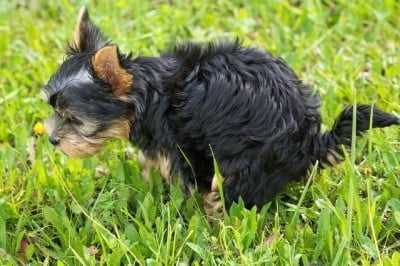
Photo by Pixabay on Pexels
One of the most essential parts of getting a puppy is potty training him. There are many ways to do that. Some parents choose to only allow their dogs to go outside, while others may employ puppy pads at home, and then there are the dog parents that combine elements of both.
Dogs thrive on a schedule, and the need for a set routine begins during puppyhood. If you choose to take your dog out to do his business, do it at the same time every day. For puppies such as Labradors, this is usually after meals. So once you put out food for your lab puppy and he’s licked the bowl clean, take him to the spot!
For dogs who have the liberty of using pee pads, you will still need to take your pup to the pad after mealtimes, but they have the freedom to go whenever they want when they grow.
The key to getting your dog to go in the same place (the right place) each time is repetition. Dogs have the natural tendency to go where they have gone before, so parents can use this to their advantage. When you see the indicators such as circling, sniffing frantically, and some whining, take your pup immediately to the potty spot. For very young puppies, we would suggest doing this right after mealtimes and drinking water because by the time you see the signs it may be too late!
We’ve even seen puppies go without showing any signs! Very young pups have poor bowel and bladder control because those organs are still developing. After going to the same spot over and over again with positive reinforcement such as treats after elimination, your dog will understand that this is where he goes.
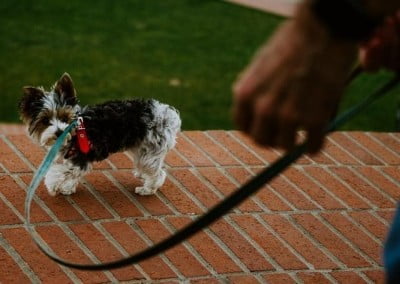
Photo by Gabe Pierce on Unsplash
Leash training is a definite necessity if you ever plan on taking your dog out, which is what 99.99% of pet parents will do. Your pooch needs to learn how to walk properly on a leash. You can single out puppies on their first walk because they will usually try to tug and bite at the leash as if it were a toy.
For an inexperienced pup, the safest thing to do is to start at home, or within any enclosed area. Some dogs may do well, but most will be distracted by the leash and try to attack and play with it. If he does this, you have to distract him by playing him.
There are various types of harnesses that are designed to address different problems such as leash pulling. Find one that works the best for your pup by determining the issues he has with leash training.
Simply correcting the behavior won’t do the trick, you have to practice often. When your dog has become accustomed to the leash, you can then practice loose leash walking and incorporate other commands into the process such as sit, and stay.
Speaking of incorporating other commands, it brings us to the basic commands to teach your dog first, before all of the other fancy tricks.
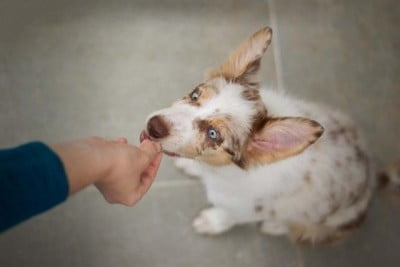
Photo by Ayla Verschueren on Unsplash
Sit is a common place to start, and it can be used as a starting point for many other commands and as a neutral position. It’s easy to do with your pup’s favorite treats, a few light pushes of his tushy, and a reward whenever he gets it right!
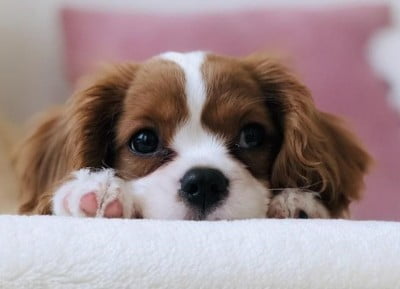
Photo by T.R Photography on Unsplash
The “down” command is similar to the sit command, except your dog is completely on the ground. Teaching your dog to go down on his tummy is easy. It involves dangling your dog’s favorite treat in front of his nose and then slowly dropping it.
Your dog will follow your movement and lay down on his belly. Remember to use the keyword “down” while you’re doing it so your dog will associate the command with the action. Then, of course, relinquish the treat in your hand!
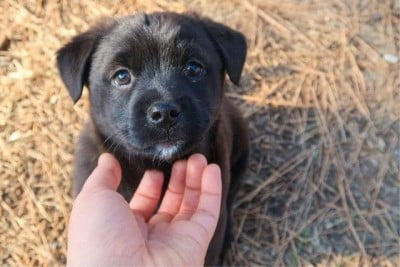
Photo by Ryu Orn on Unsplash
A dog’s recall also starts with early training, and it’s a very important one for your dog’s safety. Start with you on one side of the room or enclosed area and your dog on the other. Do whatever it takes to get him to come to you while incorporating the command word you choose (“come” is always a good one). Pick one that only has one or two syllables; it’s easier to remember for you and your dog.
Once your dog excitedly bounds toward you, you can give him a treat to reward him. Remember, practice makes perfect so make a routine of it. It is also a good relay exercise when you teach your dog to “come” to you.
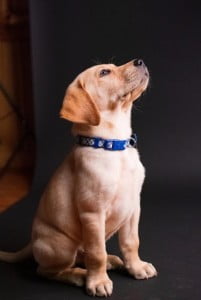
Photo by Taylor Kopel on Unsplash
The coming over to you may be easy, but the staying is where it gets tough. “Stay” is taught next to you. It really helps if your dog has already mastered the “sit” command. You can use that as the neutral position. Say the keyword “stay” and repeat it. Wait a few seconds and hand your dog a treat. This will teach him that “stay” means to be around you or to not move in the current position.
Puppy training basics covers a wide span criteria, so where do you begin? Figuring out where to start and how to build on the foundation is tough, but not if you follow our guide above. After your pooch has mastered the basics, you can expand into the fancy tricks such as “shake”, “roll over” and any other trick you can think of for bragging rights.